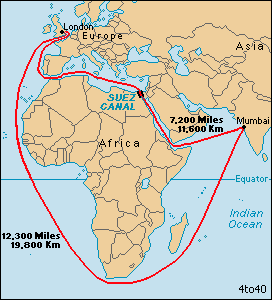 The Suez Canal, a major waterway and trade route that was completed in 1869. Cutting through the Isthmus of Suez to link the two seas, it reduces the sailing distance around the world.
The Suez Canal, a major waterway and trade route that was completed in 1869. Cutting through the Isthmus of Suez to link the two seas, it reduces the sailing distance around the world.
Learn More:
 Suez Canal, a ship canal in Egypt and a major navigational route for world trade. It crosses the Isthmus of Suez and links the Mediterranean Sea with the Gulf of Suez, an arm of the Red Sea, thus eliminating the long voyage around Africa for ships traveling between East and West. Since World War II the canal has twice been closed because of war between Egypt and Israel. When in normal operation, it is one of the world’s busiest waterways.
Suez Canal, a ship canal in Egypt and a major navigational route for world trade. It crosses the Isthmus of Suez and links the Mediterranean Sea with the Gulf of Suez, an arm of the Red Sea, thus eliminating the long voyage around Africa for ships traveling between East and West. Since World War II the canal has twice been closed because of war between Egypt and Israel. When in normal operation, it is one of the world’s busiest waterways.
In its course of slightly more than 100 miles (160 km), the Suez Canal crosses a sandy desert and passes through several natural bodies of water, including Lake Timsah and the Bitter Lakes. The canal has no locks, there being virtually no difference in the levels of the Mediterranean and Red seas. Throughout most of its length, the canal can handle only one-way traffic. Bypasses in the Bitter Lakes and at Ballah permit ships sailing in opposite directions to pass.
Widened and deepened over the years, the Suez Canal can accommodate all ships other than the largest crude-oil supertankers. Constant dredging is required to maintain the channel. The canal is operated by the Egyptian government through the Suez Canal Authority, headquartered at Ismailia. More than a dozen stations along the shore help regulate traffic. Special pilots take ships in and out of port at Port Said and Suez and navigate the canal proper. Average transit time is about 15 hours.
Crude oil and refined petroleum products, bound mainly for western Europe from the Persian Gulf area, account for most of the tonnage carried on the canal. Revenues from the operations contribute heavily to the Egyptian economy.
History:
At least as early as 1300 B.C. the Egyptians built a navigational canal linking the Red Sea with the Nile River, and indirectly with the Mediterranean Sea. It was used off and on for more than 2,000 years before being permanently abandoned in the eighth century A.D. After 1500, Europeans revived the idea of an Egyptian canal as a means of eliminating the long voyage around Africa. Nothing was done, however, until the early 19th century when surveys were made.
A French diplomat, Ferdinand de Lesseps, while serving in Egypt during the 1830’s, became interested in building a sea-level canal across the isthmus. In 1854 he obtained an exclusive concession for the project from the pasha (governor) of Egypt. The concession specified that the waterway be open to ships of all nations and that it be turned over to the Egyptian government 99 years after completion. Lesseps organized the Suez Canal Company and raised money by selling stock. More than half the shares were purchased by private investors in France, the rest by the pasha.
 Kids Portal For Parents India Kids Network
Kids Portal For Parents India Kids Network






